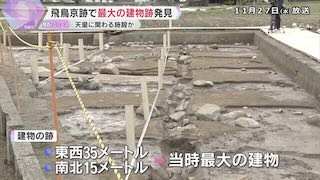NARA, Nov 28 (News On Japan) –
Remains of what is thought to be the largest building of the late 7th century have been discovered at the Asuka Palace site in Asuka Village, Nara Prefecture. It is believed to have been the residence of an emperor.
The remains were found approximately 50 meters north of a stone-paved plaza at the Asuka Palace site.
The discovery was made during excavation work conducted since October, with the building’s remains estimated to date back to the latter half of the 7th century.
According to the Kashihara Archaeological Institute, the building’s remains had been partially identified during an excavation 15 years ago. However, this time, traces of multiple pillars were uncovered, revealing its size as 35 meters east to west and 15 meters north to south, confirming it as the largest structure of its time.
The spacing between the pillars suggests it was a grand structure, likely serving as the residence of the emperor of that era. It is also considered a precursor to the later imperial palaces, such as the Heijo Palace’s inner quarters.
Source: YOMIURI

